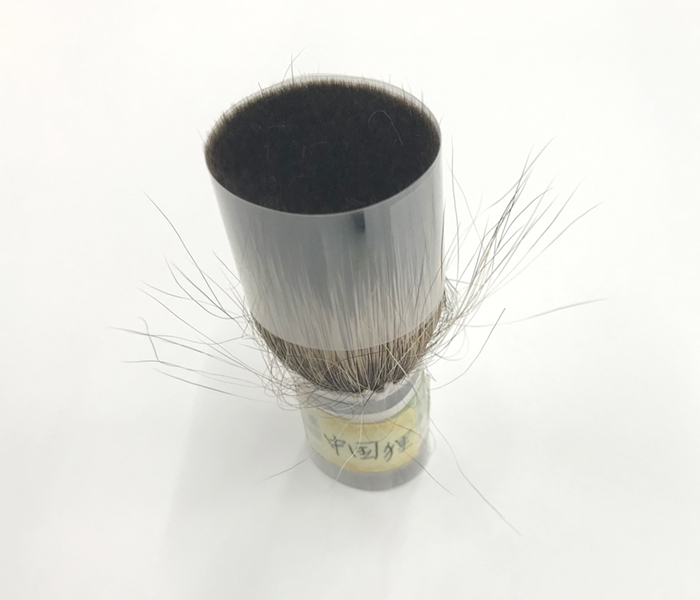- English
- 日本語



Horse hair used for brushes is taken from all over the body.Hair from the back is mainly used for watercolor or flat design brushes, hair from the belly is used for calligraphy and Japanese painting, while the scarce, precious feathery hair at the base of the tail is used for all sorts of brushes. Very little comes from Japan, with the bulk being imported from places like South America or Canada. It retains its shape quite well, holds liquid well, and makes a good all-round brush.

Ideal for oils, this is the most commonly used type of hair. Most of the hair comes from China, with Chongqing and Hankou hair being considered particularly good. Only relatively longer hairs can be taken from a single animal, and they then have to be sorted in a process known as thinning (sarae). They tend to curve, so at Namura Taiseido, we apply our proprietary techniques to make use of this curve in creating the finest-quality art brushes.


This comes from both Japan and overseas (China, Europe, Russia), although today most is imported. As brush bristles, weasel provides everything needed, with a delicate yet appropriate restorative ability. It holds liquid well, and lasts for a very long time.


This comes from either Japan or China. Japanese tanuki (raccoon dog) hair is high quality but only very small amounts can be obtained, so the bulk used for brushes is imported. Hair from the belly is an important part of brushes for calligraphy and Japanese painting, while hair from the back is used for watercolors and oils. The hair is soft, so is in demand for a wide range of applications. Hair from the back (black tanuki) and from the belly (white tanuki) have different qualities, so are used for different types of brushes.


Hair from Japan and China is used. This is one of the harder hairs used in brushes, and almost no brushes are made from pure deer hair. While strong, it lacks cohesion, so it is used for cores or heels. The hair itself is fairly bulky, holds liquid well, and has very impressive resilience. The tips of the hairs are sharp and the bases are hollow, so these hairs are particularly good at holding paint.
Mostly sourced from pets kept in Japan. White hair in particular is good quality, and the most commonly used. However, only very small amounts can be obtained, making it very expensive. The tips are extremely light and delicate. Cat is unlike any other hair. However, it wears fast, meaning brushes do not last long.

Only tail hair is used. The varying climates of Siberia, Northern Europe, China, and Japan mean that hair from each varies in length and softness. Hair from animals from colder climates is considered better quality, with Siberian Kolinsky sable being the best in terms of suppleness and resilience, making it the best quality, although expensive. It is very similar in nature to weasel hair, being delicate and appropriately able to retain its shape, hold liquid well, and wear down very slowly.。


All our goat hair is imported from China. This hair is taken from animals very similar to Japanese goats. Recent developments in China’s internal situation mean that imports have been slashed, and there are serious concerns about how to sustain brush manufacture.It holds liquid extremely well and retains its shape well. It wears slowly, making for long-lasting brushes. It also has a characteristic way of returning to its original shape, and affects how brushes feel, whether used as the main material or a secondary blend.


Hair from the ears of European bulls, this high-quality hair holds paint well and retains its shape almost as well as sable. Most of the hair we use comes from Europe, South America, or China.
With the spread of resin-based paints, nylon has become increasingly used generally for its durability and cost. Compared with early fibers, modern nylon bristles can be processed to become quite similar to animal hair. Their abilities to hold liquid and how they draw are also improving.Most of our nylon brushes are a blend of multiple types to make them easier to use. Nylon is also used in place of hairs that are becoming harder to obtain due to environmental destruction or the worsening global environment, CITES, or animal protection acts.